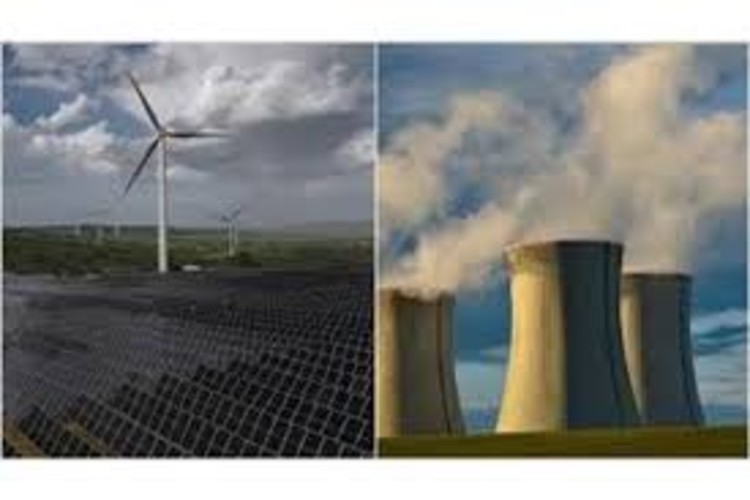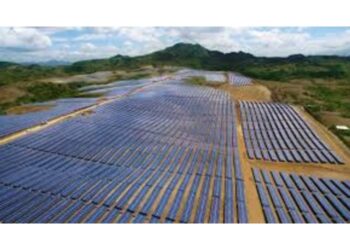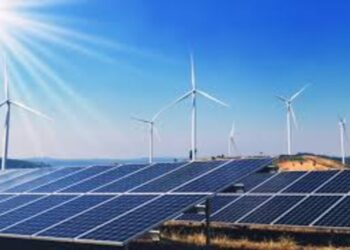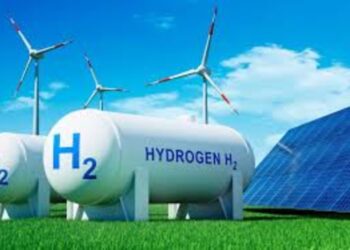Washington DC – A review by the SUN DAY Campaign of data belatedly released by the Federal Energy Regulatory Commission (FERC) reveals that the combination of solar and wind accounted for almost 96% of new U.S. electrical generating capacity added in the first third of 2025. In April, solar provided 87% of new capacity, making it the twentieth consecutive month in which solar has taken the lead.
Solar was 87% of new generating capacity in April and 78% year-to-date:
In its latest monthly “Energy Infrastructure Update” report (with data through April 30, 2025), FERC says 50 “units” of solar totaling 2,284 megawatts (MW) were placed into service in April, accounting for 86.7% of all new generating capacity added during the month.
In addition, the 9,451-MW of solar added during the first four months of 2025 was more than three-quarters (77.7%) of the new generation placed into service.
Solar has now been the largest source of new generating capacity added each month for twenty consecutive months: September 2023 – April 2025.
Solar + wind were almost 96% of new capacity added in the first third of 2025:
Between January and April, new wind has provided 2,183-MW of capacity additions, thereby accounting for 18.0% of new additions during the first four months of 2025.
For the first third of the year, the combination of solar and wind was 95.7% of new capacity while natural gas (511-MW) provided just 4.2%; the remaining 0.1% came from oil (11-MW).
Solar plus wind are almost a quarter of U.S. utility-scale generating capacity; all renewables combined are nearly a third:
The installed capacities of solar (11.0%) and wind (11.8%) are now each more than a tenth of the nation’s total. Taken together, they constitute almost one-fourth (22.8%) of the U.S.’s total available installed utility-scale generating capacity.
Moreover, at least 25-30% of U.S. solar capacity is in the form of small-scale (e.g., rooftop) systems that are not reflected in FERC’s data. [1] Including that additional solar capacity would bring the share provided by solar + wind to more than a quarter of the nation’s total.
With the inclusion of hydropower (7.7%), biomass (1.1%) and geothermal (0.3%), renewables currently claim a 31.8% share of total U.S. utility-scale generating capacity. If small-scale solar capacity is included, renewables are now about one-third of total U.S. generating capacity.
Solar remains on track to become the second largest source of U.S. generating capacity:
FERC reports that net “high probability” additions of solar between May 2025 and April 2028 total 90,158-MW – an amount almost four times the forecast net “high probability” additions for wind (22,793-MW), the second fastest growing resource. Notably, both three-year projections are higher than provided just a month earlier.
FERC also foresees net growth for hydropower (596-MW) and geothermal (92-MW) but a decrease of 123-MW in biomass capacity.
Taken together, the net new “high probability” capacity additions by all renewable energy sources over the next three years – i.e., the bulk of the Trump Administration’s remaining time in office – would total 113,516-MW.
On the other hand, there is no new nuclear capacity in FERC’s three-year forecast while coal and oil are projected to contract by 24,373-MW and 1,915-MW respectively. Natural gas capacity would expand by 5,730-MW.
Thus, adjusting for the different capacity factors of gas (59.7%), wind (34.3%), and utility-scale solar (23.4%), electricity generated by the projected new solar capacity to be added in the coming three years should be at least six times greater than that produced by the new natural gas capacity while the electrical output by new wind capacity would be more than double that by gas. [2]
If FERC’s current “high probability” additions materialize, by May 1, 2028, solar will account for one-sixth (16.6%) of the nation’s installed utility-scale generating capacity. Wind would provide an additional one-eighth (12.6%) of the total. Thus, each would be greater than coal (12.2%) and substantially more than either nuclear power or hydropower (7.3% and 7.2% respectively).
In fact, assuming current growth rates continue, the installed capacity of utility-scale solar is likely to surpass that of either coal or wind within two years, placing solar in second place for installed generating capacity – behind only natural gas.
The combined capacities of all renewables, including small-scale solar, may overtake natural gas within three years:
The mix of all utility-scale (i.e., >1-MW) renewables is now adding about two percentage points each year to its share of generating capacity. At that pace, by May 1, 2028, renewables would account for three-eighths (37.7%) of total available installed utility-scale generating capacity – rapidly approaching that of natural gas (40.1%). Solar and wind would constitute more than three-quarters of the installed renewable energy capacity. If those trendlines continue, utility-scale renewable energy capacity should surpass that of natural gas in 2029 or sooner.
However, as noted FERC’s data do not account for the capacity of small-scale solar systems. If that is factored in, within three years, total U.S. solar capacity (i.e., small-scale plus utility-scale) could exceed 300-GW. In turn, the mix of all renewables would then be about 40% of total installed capacity while natural gas’ share would drop to about 38%.
Moreover, FERC reports that there may actually be as much as 224,426-MW of net new solar additions in the current three-year pipeline in addition to 69,530-MW of new wind, 9,072-MW of new hydropower, 202-MW of new geothermal, and 39-MW of new biomass. By contrast, net new natural gas capacity potentially in the three-year pipeline totals just 26,818-MW. Consequently, renewables’ share could be even greater by mid-spring 2028.
“The Trump Administration’s ‘Big, Beautiful Bill’ now being debated by the Republican-controlled Congress poses a clear threat to solar and wind in the years to come,” noted the SUN DAY Campaign’s executive director Ken Bossong. “Nonetheless, FERC’s latest data and forecasts suggest cleaner and lower-cost renewable energy sources may still dominate and surpass nuclear power, coal, and natural gas.”













